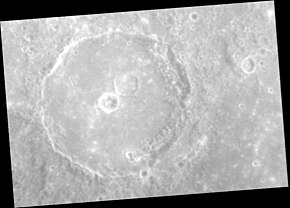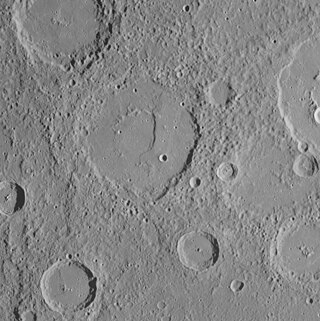
Boethius is a crater on the planet Mercury. It was named after Anicius Manlius Severinus Boethius, the Roman philosopher, by the IAU in 1976. The crater was first imaged by Mariner 10 in 1974.

Bach is a double-ringed impact basin within the Bach quadrangle of Mercury. It was named by the IAU in 1976.

Vivaldi is a crater on Mercury. It was named by the IAU after Italian composer Antonio Vivaldi in 1976. It has a prominent and nearly continuous inner ring whose diameter measures about half that of the outer ring. It is one of 110 peak ring basins on Mercury. Unlike some of the lunar multiringed structures, no vestiges of additional rings are apparent around this crater. It is classified as c3 age.

Mozart is a crater on Mercury, named by the IAU in 1976 after Austrian composer Wolfgang Amadeus Mozart.
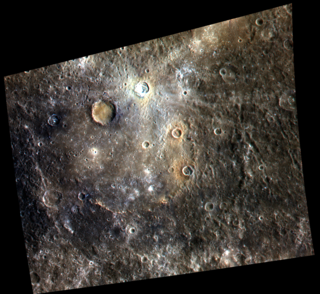
Homer is a crater on Mercury. It is one of 110 peak ring basins on Mercury. It is Tolstojan in age.
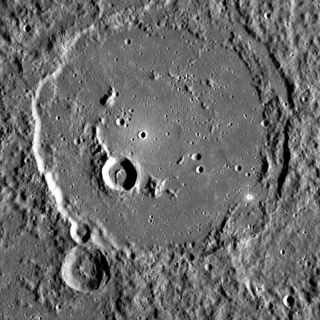
Polygnotus is a crater on Mercury, named by the IAU in 1976, after ancient Greek painter Polygnotus. The crater was first imaged by Mariner 10 in 1974.

Praxiteles is a crater on Mercury. It is one of 110 peak ring basins on Mercury.

Raditladi is a large impact crater on Mercury with a diameter of 263 km. Inside its peak ring there is a system of concentric extensional troughs (graben), which are rare surface features on Mercury. The floor of Raditladi is partially covered by relatively light smooth plains, which are thought to be a product of the effusive volcanism. The troughs may also have resulted from volcanic processes under the floor of Raditladi. The basin is relatively young, probably younger than one billion years, with only a few small impact craters on its floor and with well-preserved basin walls and peak-ring structure. It is one of 110 peak ring basins on Mercury.

Munkácsy, named after Mihály Munkácsy, is a crater on Mercury. Munkácsy originally had a double-ring basin structure, but most of the inner ring was buried when the basin was flooded with volcanic lava. Only a few remnants of the ring poke up through the lava, although low ridges in the lava seem to trace out much of the rest of the ring's circumference. Munkácsy is one of 110 peak ring basins on Mercury.

Izquierdo is a crater on Mercury. Its name was adopted by the International Astronomical Union (IAU) in 2009, for the Mexican painter María Izquierdo. The floor of Izquierdo is smooth, the result of having been partially filled with volcanic lava. Circular outlines of the rims of “ghost craters” – smaller, older craters that have been largely buried by the lavas that infilled the basin – are visible in a few places on Izquierdo's floor. The remnants of a buried inner ring are also barely discernible in spots, and it is one of 110 peak ring basins on Mercury. There have been more recent impacts into the floor of Izquierdo, resulting in some small, sharply defined craters.

Scarlatti is a pit-floored crater on Mercury, which was discovered in 1974 by the Mariner 10 spacecraft. It has a prominent peak ring, and it is one of 110 peak ring basins on Mercury. The crater floor is covered by the smooth plains material. The crater displays an arcuate collapse feature along the northeastern peak ring. The size of the pit, which was first noticed in MESSENGER images obtained in January 2008, is 38 × 12 km. Such a feature may have resulted from collapse of a magma chamber underlying the central peak ring complex of the crater. The collapse feature is an analog of Earth's volcanic calderas. Scarlatti is thought to have the same age as the Caloris basin.
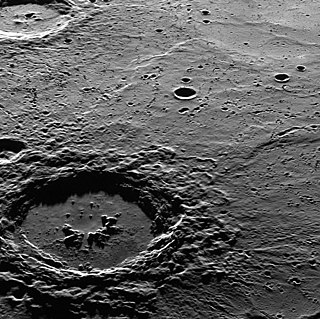
Hokusai is a rayed impact crater on Mercury, which was discovered in 1991 by ground-based radar observations conducted at Goldstone Observatory. The crater was initially known as feature B. Its appearance was so dissimilar to other impact craters that it was once thought to be a shield volcano. However, improved radar images by the Arecibo Observatory obtained later in 2000–2005 clearly showed that feature B is an impact crater with an extensive ray system. The bright appearance of rays in the radio images indicates that the crater is geologically young; fresh impact ejecta has a rough surface, which leads to strong scattering of radio waves.

Rachmaninoff is an impact crater on Mercury. This basin, first imaged in its entirety during MESSENGER's third Mercury flyby, was quickly identified as a feature of high scientific interest, because of its fresh appearance, its distinctively colored interior plains, and the extensional troughs on its floor. The morphology of Rachmaninoff is similar to that of Raditladi, which is one of the youngest impact basins on Mercury. The age of Raditladi is estimated at one billion years. Rachmaninoff appears to be only slightly older.

Aksakov is a crater on Mercury. It has a diameter of 174 kilometers. Its name was adopted by the International Astronomical Union (IAU) on April 24, 2012. Aksakov is named for the Russian author Sergey Aksakov, who lived from 1791 to 1859 C.E.

Mark Twain is a crater on Mercury. Its name was adopted by the International Astronomical Union (IAU) in 1976. Mark Twain is named for the American author Mark Twain, who lived from 1835 to 1910.
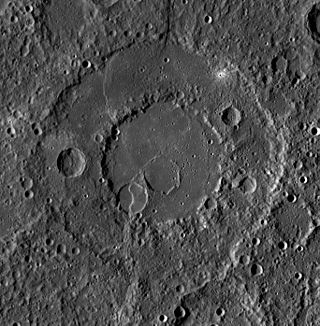
Renoir is a crater on the planet Mercury. Its name, after the French painter Pierre-Auguste Renoir (1841–1919), was adopted by the International Astronomical Union in 1976.
Ghost craters on the planet Mercury have tectonic features such as graben and wrinkle ridges. These features were formed by extensional and contractional forces originating in tectonic processes such as uplift and global contraction. The combination of graben and wrinkle ridges inside ghost craters found on Mercury has not been observed on any of the other terrestrial planets.

Holst is a crater on Mercury. Its name was adopted by the International Astronomical Union (IAU) on April 24, 2012.

Aneirin is a crater on Mercury. It has a diameter of 467 kilometers. Its name was adopted by the International Astronomical Union (IAU) on June 13, 2014. Aneirin is named for the Welsh poet Aneirin. Prior to naming, the crater was referred to as b37. It is Tolstojan in age.

Rustaveli is a crater on Mercury. Its name was adopted by the International Astronomical Union in 2012, after the Georgian poet Shota Rustaveli.
